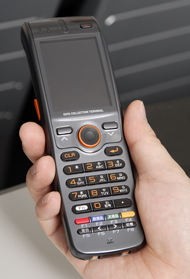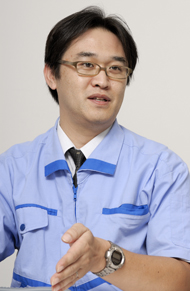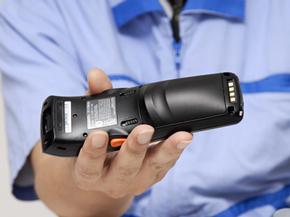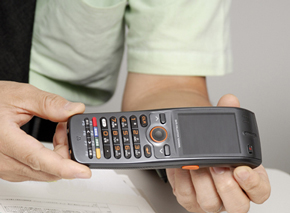Design for the hands of the user;
A handheld terminal developed for "usability" with objective method
The DT-X7 series handheld terminal is CASIO's latest product which fully integrates the Human-Centered Design ("HCD") methodology. Analyzing "usability" objectively, CASIO claims to have created a device to meet the practical needs of users.
Handheld terminals are important information devices which enable logistics, retail and field service operators to connect goods and systems at the respective sites. They are loosely divided into three types: the "grip type" with a built-in bar code scanner for use in logistics and retailing, the "PDA type" for data input and output-focused tasks, and the "printer type" for use in issuing traffic and parking offense tickets and train tickets on-board, and reading public utility meters. However, the business orientation of handheld terminals has meant that their development has tended to focus on aspects which can be numerically analyzed, such as functions, dimensions and cost.

DT-X7 series Handheld Terminal
While ways to innovate the shape and positioning of keys to create user-friendly designs have been devised, there has been a virtual absence of objective design evaluation methods. This points out to a failure by manufacturers to adopt a design-oriented approach used in the development of "consumer devices".
The fact remains, however, that logistics operators in the warehouse and retail staff on the shop floor are the ones actually using handheld terminals and the usability of these devices can significantly impact upon operating efficiency.
CASIO has fully integrated the Human-Centered Design methodology into the development of a grip-type handheld terminal while objectively evaluating "usability" and "fatigue prevention" throughout the design process.
The DT-X7, launched in overseas markets in October, is the culmination of these efforts.
At first glance, the DT-X7 resembles a multi-functional mobile phone. In fact, it shares a number of features with recent mobile phones including the positioning and color coding of the keys and the clear resin finish around the screen. However, CASIO states that most of these similarities are simply the results of the design process.
Koichi Sato of Design Center in the Development Headquarters was responsible for overseeing the promotion of this Human-Centered Design process. We also spoke to Motoyuki Matsui, Manager of the Product Engineering Department, and Tomoyuki Nihei of Product Development Department at the Hachioji Product Development Headquarters, who were both involved in planning and design of the DT-X7.
Involving designers and marketing from the development stage
------ I have heard that the DT-X7 adopted the Human-Centered Design methodology in all aspects of its design. What was the motivation behind this approach?

Tomoyuki Nihei at the Hachioji
Product Development Headquarters
Nihei: This project began in earnest in around February 2006.
Prior to this, we carried out in-depth research in the distribution and retail handheld terminal markets and found that many users focused on the practical usability of the device. This came as somewhat of surprise to us because we thought that the majority of users would value functionality, but it also served as a reminder that users are looking forquality in terms of basic usability in a market where the gap in functionality is narrowing among manufacturers. That is why we embarked upon a comprehensive pursuit of practical usability.
Matsui: The development flow is also different. Usually the planning department works out the specifications and then the designers give these plans form, but we were committed to involving the designers and sales representatives from the initial planning stage and especially to incorporating the opinions of actual users into the product.
------ So the development flow was similar to a "spiral model" rather than a "waterfall model"?
Nihei: The development style evolved naturally as a result of integrating the Human-Centered Design process into the development system. This is probably the first time that CASIO has undertaken a development project which fully integrates this process.

Lined mockups used in the first stage till the final development stage
Matsui: We also created a number of mockups based on user opinions and evaluated them on subjects with various physical attributes in order to make further improvements. Through this workflow, we gradually created the device by giving form to usability.
Sato: First we created five evaluation mockups together with the section in charge of product design that reflected the opinions of actual users. We created two mockups as improved versions based on the subjects' evaluations. The design which came about as result of further evaluation became the basic shape of the DT-X7.
Evaluation on two gripping methods by numeric value
------ It must be difficult to evaluate "usability", unlike specifications printed on a catalogue which can be valued numerically. What approach did you use?
Nihei: First we came up with four criteria: "lightweight", "easy to hold", "easy scanning operation" and "easy key operation". Many of the users are in fact women with small hands so we thought it was important that the device be lightweight and compact to suit a woman's hand.
The term "usability" is often used but it is a concept that cannot be expressed numerically, which makes it difficult to determine how to create a product that is easy to use. By integrating the Human-Centered Design process, analyzing the factors that constitute usability and carrying out various analyses and tests on users' physical attributes and work environments, we created a "criteria of the usability" to incorporate into the product.

Koichi Sato at the Design Center
Sato: In terms of design, we have carried out designing with "affordance" in mind (originally a psychology term, affordance is a coined word formed from the transitive verb "afford" meaning "to provide" and the suffix "ance", and refers to the concept of a person's recognition of an object and the relationship of their interaction with that object based thereupon) so that the user could intuitively grasps the device and use it without the need for guesswork.
We also carried out various tests. We objectively evaluated usability together with Associate Professor Nagao of the Chiba Institute of Technology. This also involved experiments in which subjects used the device after being fitted with an eye-mark recorder to monitor eye movements and an electromyograph ("EMG") to measure muscle tension. We also adopted a method which compared the subjective evaluations of the subjects both before and after using the device. By examining these test results as numerical statistics, we were able to perform objective evaluations.
Matsui: We spent about six months deciding on the product shape but repeated these evaluations up until the final stage. We carried out tests over and over to verify whether the product really was easy to use.
Nihei: For an example, there are two ways to hold a grip-type handheld terminal. It may help if you imagine a convenience store or supermarket.
When filling up stocks on the shelf, the user scans the bar code appearing on the price tag on the shelf and enters a value using numerical keys. In this case, the user holds the terminal in his (or her) palm and operates the numeric keys with his (or her) thumb. The scanner is operated with the Trigger Center key located just below the screen.
On the other hand, when the user is checking incoming goods, the user holds the goods in one hand and the terminal in the other hand to scan the bar code to verify whether the quantity of the incoming goods matches the quantity displayed. In this case, the user grasps the terminal from above while the terminal is placed in an upright position with the screen up so the scanner is operated with one of the side trigger keys.
For either way to hold the terminal, we have arranged the scan trigger keys at several suitable positions for "easy to hold" and "easy to operate" in mind.
The design innovation and impressive functionality improve usability
------ You mentioned that you repeated the evaluations until the product was completed. What specific aspects of this evaluation helped to realize the device's usability and in what way?

A body designed for scanning efficiency
Matsui: For example, the tip of the terminal appears to be on an angle downward when viewed from the side. This downward angle matches the direction of the scanner's emitted laser beam.
Sato: According to the eye-mark recorder data, this led to a dramatic reduction in the user's eye movements. Previous handheld terminals required intensive eye movements as the user's line of sight followed the aimer (the laser beam which performs scanning) around the price tag. The data indicated an increase in the number of times the aimer can correctly focus to the bar code on the first attempt upon pressing the scan trigger key without miss-shooting at above or below of the bar code and consequently a decrease in the number of errors.

Motoyuki Matsui, Manager of the Product Engineering Department
Matsui: The terminal has a raised contour on the back to make it easier to hold and there are shallow grooves for the user's fingers where the terminal's center of gravity is also adjusted to optimize these features. Also, the center key is positioned to facilitate natural finger movement and frequently-used keys are aligned within the range of easy finger access.
Sato: This has considerably decreased the frequency with which the user has to re-grip the terminal while minimizing hand and finger strain, which means that it minimizes user fatigue.
Matsui: Even when re-gripping the terminal, the grooves on the back act as a guide for the user's fingers and the resulting fit contributes to stability in the hand.
Sato: Judging by the subjective evaluations, there was a significant improvement after use so we can assume that the usability has been well received. Comparing these subjective evaluations to those of the previous handheld terminals and competitor's products, we are confident that the DT-X7 received high evaluations overall.
Nihei: Equipping the terminal with a voice-based guidance was another aspect of the usability. This function reduces the need to repeatedly look at the screen when inspecting goods, so the user's eye movements decrease. The 2.4-inch QVGA transflective color LCD is very effective because it enhances the screen's contrast and makes it easier to read, as well as displaying an operating guide which matches the color of the function keys, F1 to F4, on the keyboard. That is also why the terminal has those colorful keys.
We also focused on ease of implementation by equipping the terminal with relevant tools, such as support tools, to develop applications and to build a wireless communication environment.
Realizing design without sacrificing functionality
------ The DT-X7 is a business support device so am I right to assume that its design has not been given priority at the expense of functionality?
Nihei: Of course, the terminal is fully equipped with all of the functions sought on the current market. In addition to communication functions such as WLAN, Bluetooth, USB and IrDA, the terminal also comes with a color LCD and two types of battery pack (available as option), standard and large-capacity, and we haven't compromised on other functions either.

The grip features a raised contour for easy holding
Matsui: The raised contour on the back of the terminal is impressive and may appear large at first glance but it has in fact been provided to realize an easy-to-hold shape and a balanced center of gravity.
This forms the battery cover which, when removed, reveals that theraised contour is largely empty. The areas of the device equipped withcomponents are thin and lightweight. This meant that an extremely small substrate was required, which caused the designers quite a lot of struggle.
------ A lot of work appears to have gone into fitting the components.
Matsui: Our handheld terminals are usually equipped with a capacitor on the substrate to act as a backup power source in case the terminal is dropped and the battery comes out or the battery contact comes loose but this requires the use of several large components such as coils which are an impediment to miniaturization.
We therefore devised a new low-resilience terminal which imitates the movement of the battery to reduce the chances of the battery contact coming loose. One end of the battery compartment also features a protrusion to prevent the battery from falling out upon impact. These innovations have eliminated the need for a backup power source formed with the capacitor.
We have also actively adopted ultra-compact components similar to those used in mobile phones in an effort to make the entire base more compact. For example, the chip resistor size is 0603 (or 0.6 mm x 0.3 mm). The use of ultra-small components like this chip resistor has made it possible to make the terminal lighter and more compact.
------ The method for fixing the circuit boards has also been changed from screws to a snap-in design.
Matsui: We wanted to save the space taken up by the large, heavy screws. By introducing a snap-in method, we have created a floating structure which reduces damage to the circuit boards. By making the body curved and re-selecting the materials, we managed to decrease the case thickness and enhance its strength.
Designing a product that makes users "wish to use" or "wish to continue the use"
------ The design of the DT-X7 closely resembles that of a mobile phone. Is it safe to say that the mobile phone culture has had some kind of influence?
Nihei: Literacy in terms of the usability is something that is shared even among different products. Although we didn't intentionally try to liken the terminal's design to that of a mobile phone, our pursuit of the usability has, to a certain extent, resulted in just that.
Sato: One of the reasons that happened was that we were conscious of female users. Many women are quite adept at sending mail on their mobile phones so I think that our attempts to make the terminal operable for women in a manner with which they were comfortable naturally led to a shape which resembles that of a mobile phone.
------ The terminal also features some areas which seem to go beyond mere practicality, such as the use of transparent components on the screen's border.

Color coding and other refined design including the layout of keyboard which resembles a mobile phone rather than a typical handheld terminal offers users a good impression at the first glance.
Nihei: CASIO sales representatives were involved in the DT-X7's development so the end user's point of view was also considered in the product concept. This made us aware of the importance of first impressions among users as well as providing them with a sense of satisfaction, and this is reflected in the terminal's refined design and overall feeling of high-quality in addition to its usability.
Sato: We also considered the appearance so that female store personnel would see the terminal and instantly want to use it. In addition, we considered the fact that, in the case of retailers, the store's customers would probably see the terminal as well. They are referred to as "tertiary users". If a store selects its handheld terminals in the awareness that they will likely be seen by their customers, then we should be concerned with the terminal's appearance.
------ The terminal has been released already. After marketing has began, what have your customers responded?
Nihei: Our marketing department reports that there have been a considerable number of inquiries. Customers have also had favorable first impressions and we have heard that our sales representatives feel confident marketing this product.
------ Does everyone involved in the development feel confident in the making of this product?
Matsui: In the past I had a strong sense of relief upon completing the development of a new product but this time I have an intense feeling of satisfaction at having created a product just as we had conceived it. I think that this is a product which we can pass on with confidence. I guess I would feel a sense of elation if I could see the terminal actually being used in a warehouse or on a shop floor.
Sato: This project has also been a major challenge for the Design Center. This is the first time that CASIO has developed a product which has continuously integrated the Human-Centered Design process from start to finish. This experience will probably be applied to the development of products in other areas in the future.
Our next challenge will be how to incorporate the feedback of users of the DT-X7 into our next product.